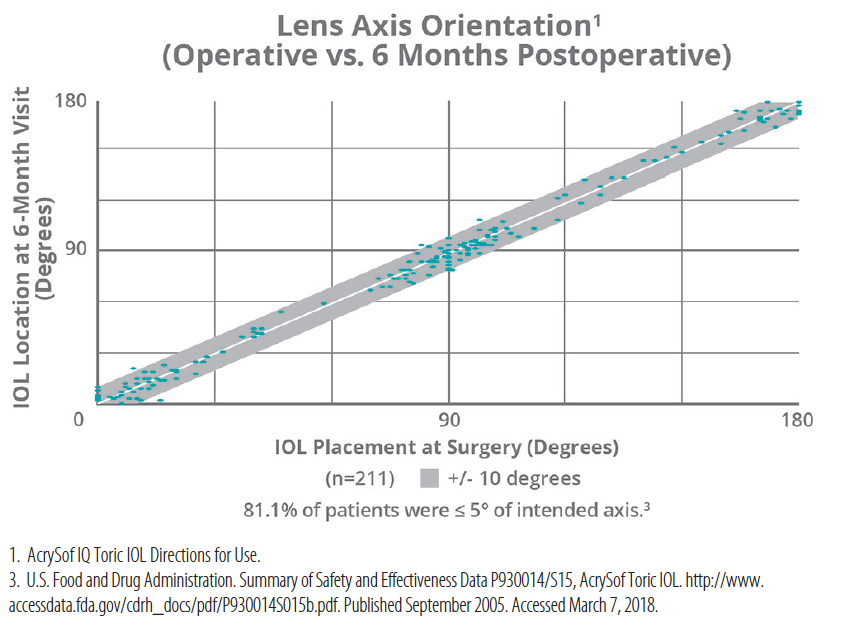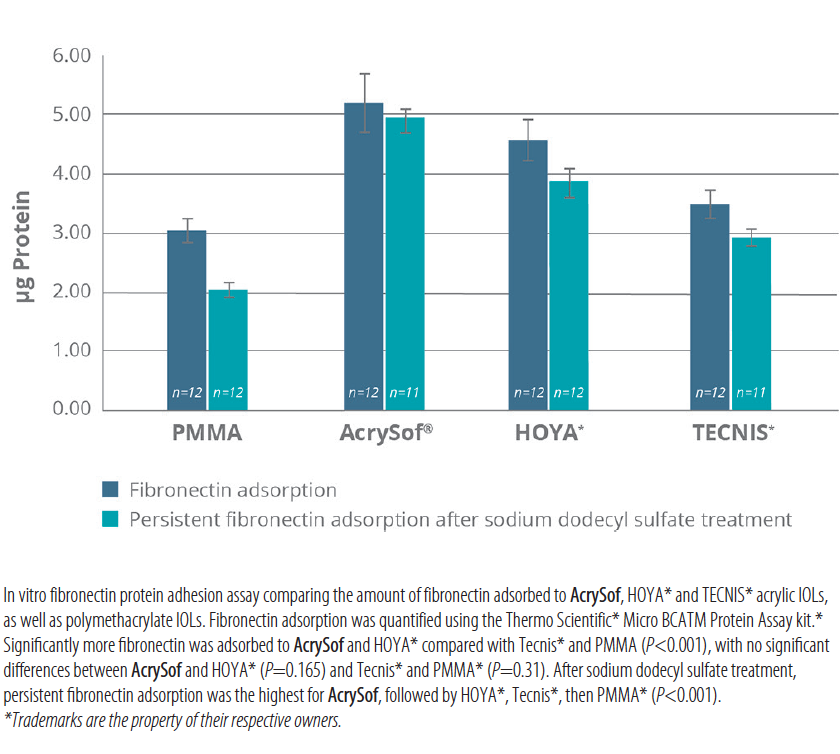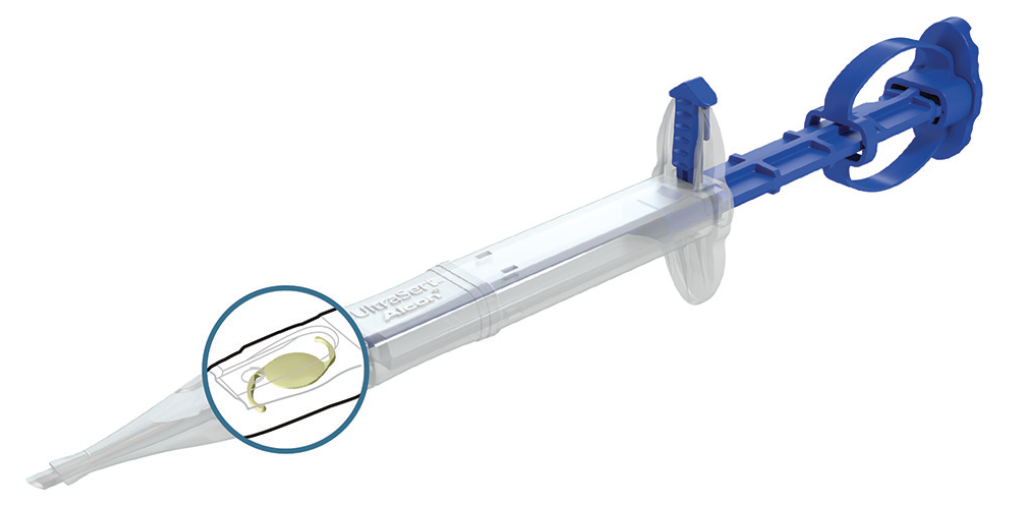We have so many choices in cataract surgery today, and every surgeon has preferences. For me, that means a mix of niche and workhorse IOLs. My workhorse is the AcrySof IQ platform. The science and design behind these monofocal, toric, and multifocal lenses help deliver exceptional outcomes for my patients every day, and they allow me to perform smooth, elegant, and highly predictable procedures.
Aspheric Monofocal Lens
The AcrySof IQ aspheric monofocal lens (Alcon) showed improved functional vision versus a spherical monofocal IOL,1 in large part due to its unique BioMaterial, BioMechanics and BioOptics. Its asphericity is designed to deliver the same total spherical aberration as found in the youthful eye, which helps give patients good contrast sensitivity.2 The AcrySof IQ design and the blue light chromophore has also been reported to help reduce glare during night-time driving.3-5
The crystalline lens increases in sphericity as the eye ages. The spherical aberration of the AcrySof IQ lens combined with the aberration of the cornea returns the eye to its youthful aberration state. The goal for optimal vision is for the total spherical aberrations to be slightly positive at 0.1 μm.2,6
The AcrySof IQ IOL has a haptic design that enables conformation to the shape of the capsular bag with consistent compression force. The results are precise centration, predictable refraction, and stable positioning over the long term.
I consider the AcrySof IQ monofocal the top-of-the-line option in its category, and it is my standard lens of choice. I want a lens that is consistently straightforward to implant in the capsular bag, centers well, and delivers the quality of vision that patients desire. That is exactly what the AcrySof IQ lens does. It makes my patients happy. I’ve used the lens on photographers, painters, and designers, all of whom require a high degree of color appreciation, precision, and sharpness, and I have received positive reviews from these patients.
Toric and ReSTOR Multifocal Lenses
With the same BioMaterial, BioMechanics, and BioOptics benefits as the Acrysof IQ monofocal lens, two other excellent lenses in this line are the AcrySof IQ toric IOL (Alcon) and AcrySof IQ ReSTOR multifocals (Alcon).
For patients with astigmatism who want to rely less on glasses for their distance vision, I choose the AcrySof IQ toric lens above other torics because of its stability. Like the AcrySof IQ monofocal, the toric lens does not rotate. It remains in its optimal position long term (Figure 1). The AcrySof BioMaterial, a hydrophobic acrylic polymer that is highly biocompatible, offers greater fibronectin bioadhesion than other monofocal lens materials in vitro (Figure 2).7 Fibronectin bioadhesion, combined with other key design features, contributes to the excellent adhesion of this IOL to the capsular bag.

Figure 1. Mean lens axis orientation from operative visit to 120 to 180 days postoperatively.

Figure 2. In vitro fibronectin absorption.
At 6 months, 62% of patients with the AcrySof IQ toric lens had ≤ 0.50 D residual refractive cylinder, while 88% had ≤ 1.00 D.8 In the same period, the lens was within 5° of the intended axis in 81.1% of patients.8 I am confident that the lens will not move. It stays where I place it, and it works. Because the AcrySof IQ toric IOL offers a range of spherical powers (+6.00 D to +34.00 D in half-diopter increments) and cylinder powers (seven, ranging from 0.75 D to 4.11 D), I can use the lens to achieve excellent outcomes for many of my astigmatic patients.
The AcrySof IQ ReSTOR +2.5 IOL with the ACTIVEFOCUS optical design is my lens of choice for patients who want presbyopia correction. The lens has a lot of options, which make it ideal for tailoring treatment to patients’ activities and visual goals. I like to combine the ReSTOR +2.5 with ACTIVEFOCUS design lens and the ReSTOR +3.0 lens for maximum patient benefit. I typically implant the ReSTOR +2.5 with ACTIVEFOCUS design lens in the dominant eye and the ReSTOR +3.0 lens in the nondominant eye. I believe that by using the ReSTOR +2.5 with ACTIVEFOCUS design lens, which is predominantly for distance, in the dominant eye that glare and halo are likely to be reduced due to the aspheric IOL design and excellent contrast sensitivity demonstrated with ReSTOR +2.5 with ACTIVEFOCUS design lens. Anecdotally, I have seen patients complain of less glare and halos with this approach, compared to other IOLs. This will need more rigorous study in the future.
I appreciate the unique ACTIVEFOCUS design used in the ReSTOR +2.5 IOL. Like prior ReSTOR models, the lens has apodized segment heights that change the percentage of light focused on near and far across the lens, allowing more light to be concentrated on the distance image and near image depending on the pupil size. This is a proven platform. I routinely get patients now with 20/15 distance vision with this lens. This is one of countless examples why Alcon's IOL platform remains my long-standing workhorse.
Blue Light Filtration and Ultraviolet blocking
The AcrySof IQ platform is available in two separate options, a blue light-filtration lens and a ultraviolet blocking-only lens. The blue light-filtration lens features a natural chromophore that mimics the healthy, natural crystalline lens’ transmission of light.4 Complementing the lens’ spherical aberration, blue light filtration also enhances contrast, helps reduce glare, and assists the eye in recovering from photostress.4
A study comparing the effects of blue light-filtering lenses with those that do not filter blue light found that this feature significantly reduced glare disability.4 Contrast sensitivity was much better in the blue light-filtering eyes, and eyes recovered from photostress much faster.4,9 For patients or surgeons who prefer ultraviolet blocking, the AcrySof IQ is also available in an ultraviolet blocking-only lens.
Smooth, Efficient Implantation
I have used the lenses in the AcrySof IQ platform for years, and it is by far my favorite go-to lens platform. Outcomes factor most heavily in that choice, and the ease and efficiency of the surgical procedures are compelling as well. In my experience, most of the AcrySof IQ IOLs (monofocal, toric, and multifocal) can be inserted through a small 2.2-mm incision if desired.

Figure 3. UltraSert Pre-Loaded Delivery System with the AcrySof IQ monofocal IOL.
I have implanted the AcrySof IQ monofocal with the UltraSert Pre-loaded Delivery System (Alcon) for several years. The delivery system is intuitive, and my staff and I do not need to handle and load the lenses, so the IOL remains pristine and untouched (Figure 3). In my experience with UltraSert, the AcrySof IQ lenses are delivered into the eye beautifully. Occasionally, I will have to reposition a haptic during delivery when using UltraSert. This repositioning takes seconds and simply entails rotating the lens into the bag. Overall, surgery with the UltraSert Pre-loaded Delivery System mirrors the lenses themselves, with an elegant design and comforting predictability that ultimately provide excellent outcomes for my patients.
1. AcrySof IQ IOL Directions for Use.
2. Wang L, Santaella RM, Booth M, Koch DD. Higher-order aberrations from the internal optics of the eye. J Cataract Refract Surg. 2005;31:1512-1519.
3. Alcon. Data on Fil.
4. Hammond BR Jr, Renzi LM, Sachak S, Brint SF. Contralateral comparison of blue-filtering and non-blue-filtering intraocular lenses: glare disability, heterochromatic contrast, and photostress recovery. Clin Ophthalmol. 2010;4:1465-1473.
5. Gray R, Perkins SA, Suryakumar R, et al. Reduced effect of glare disability on driving performance in patients with blue light-filtering intraocular lenses. J Cataract Refract Surg. 2011;37(1):38-44.
6. Levy Y, Segal O, Avni I, Zadok D. Ocular higher-order aberrations in eyes with supernormal vision. Am J Ophthalmol. 2005;139(2):225-228.
7. Ong M, Wang L, Karakelle M. Fibronectin adhesive properties of various intraocular lens materials. Alcon Laboratories, Fort Worth, TX, USA. ARVO 2013.
8. US Food and Drug Administration. Summary of Safety and Effectiveness Data P930014/S15, AcrySof® Toric IOL. http://www.accessdata.fda.gov/cdrh_docs/pdf/P930014S015b.pdf. Published September 2005. Accessed February 21, 2018.
9. Fisher BL, Hammond BR Jr, Venkiteshwar MS. Visual effects of additional short-wave filtering in patients with clear intraocular lenses. Poster presented at: ASCRS; April 25-29, 2014; Boston, Massachusetts.

